Vous n’arrivez pas à accéder à votre site WordPress ?
Parfois, les pirates vous empêchent d’accéder à votre propre site en supprimant votre compte administrateur de la base de données.
Dans cet article, nous allons vous afficher comment ajouter un compte administrateur à la base de données de WordPress via MySQL afin que vous puissiez récupérer votre accès.
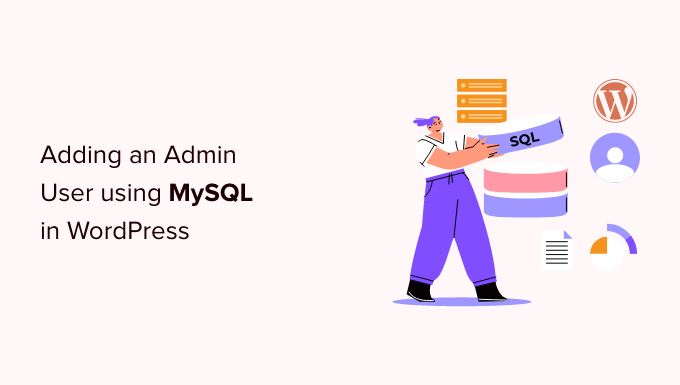
Pourquoi ajouter un utilisateur/utilisatrice à la base de données de WordPress via MySQL ?
Nous avons rencontré une fois un problème où le site d’un utilisateur a été piraté, et son compte admin a été supprimé de la base de données. Cela l’a empêché d’accéder à son site WordPress.
Nous avons pu les aider à accéder à leur site en créant un nouvel utilisateur/utilisatrice administrateur directement sur le site WordPress. Pour ce faire, nous avons utilisé phpMyAdmin, un outil web qui vous permet de gérer les bases de données MySQL à l’aide de votre navigateur.
Si vous vous trouvez bloqué hors de votre zone d’administration WordPress à cause de pirates ou simplement parce que vous avez oublié votre mot de passe, alors vous pouvez faire de même.
Cependant, vous devriez toujours faire une sauvegarde de votre base de données avant d’effectuer des modifications sur MySQL. Ensuite, une fois que vous pourrez vous connecter à nouveau à votre site, vous devrez peut-être suivre notre guide du débutant pour corriger votre site WordPress piraté.
Ceci étant dit, voyons comment ajouter un utilisateur/utilisatrice administrateur à la base de données de WordPress via MySQL.
Ajout d’un utilisateur/utilisatrice dans la base de données de WordPress avec phpMyAdmin
phpMyAdmin est préinstallé chez la plupart des entreprises d’hébergement WordPress. Vous le trouverez dans la section Bases de données du tableau de bord cPanel de votre compte d’hébergement.
Voici une capture d’écran du panneau de contrôle de Bluehost:
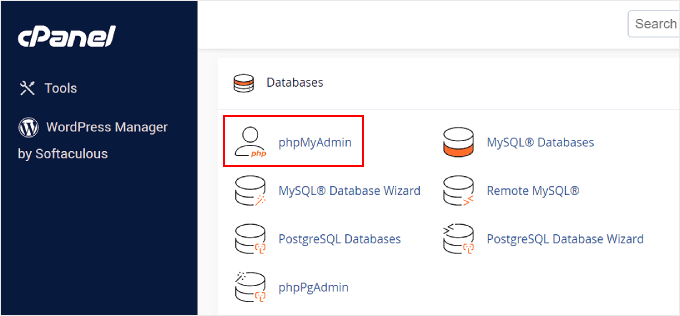
En cliquant sur l’icône, vous ouvrirez l’interface de phpMyAdmin. Vous devez sélectionner votre base de données WordPress dans la colonne de gauche.
Ensuite, phpMyAdmin affichera toutes les tables de votre base de données WordPress. Vous allez apporter des modifications aux tables wp_users et wp_usermeta.
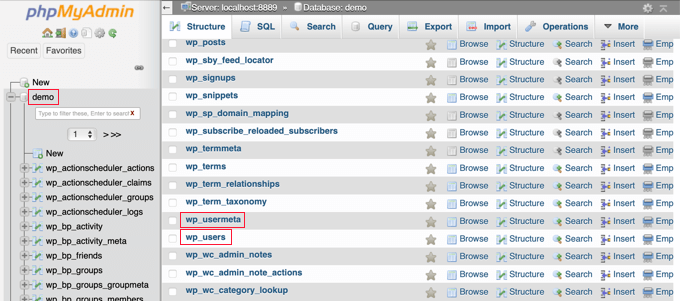
Ajout d’un compte dans la table wp_users
Tout d’abord, vous devez trouver le tableau wp_users et cliquer dessus. Cela affichera les utilisateurs/utilisatrices actuellement répertoriés dans le tableau.
Notez dans la capture d’écran ci-dessous qu’il y a deux ID d’utilisateur dans le tableau de notre site de démonstration, 1 et 2. Lorsque nous créons un nouvel utilisateur pour notre site de démonstration, cet ID doit être unique, nous allons donc taper le chiffre 3.
Vous devez cliquer sur l’onglet « Insérer » en haut de l’écran afin d’insérer les informations relatives à un nouvel utilisateur/utilisatrice.
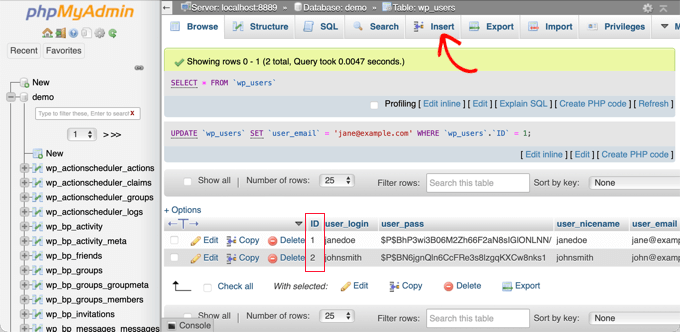
Ajoutez les informations suivantes aux champs du formulaire d’insertion :
ID: choisissez un numéro unique (dans notre exemple, nous utiliserons 3)user_login: l’identifiant qui sera utilisé pour se connecter.user_pass: ajoutez un mot de passe, et assurez-vous de sélectionner MD5 dans le menu de fonction (voir la capture d’écran ci-dessous)user_nicename: le nom complet ou le Pseudonyme de l’expéditeur.user_email: l’adresse e-mail du compte.user_url: l’adresse de votre siteuser_registered: sélectionner la date et l’heure où le compte a été inscrit à l’aide du calendrieruser_activation_key: laisser videuser_status: définir cette valeur à 0display_name: le nom complet ou le nom affiché de l’utilisateur/utilisatrice.
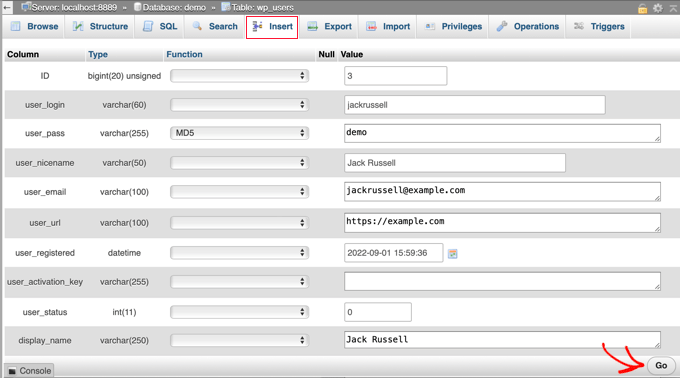
Une fois que vous avez terminé, cliquez sur le bouton « Go » pour stocker le nouvel utilisateur.
Ajout d’un compte dans la table wp_usermeta
Maintenant, vous devez trouver la table wp_usermeta et cliquer dessus. Après cela, vous devez cliquer sur l’onglet » Insérer » comme vous l’avez fait à l’étape précédente.
Ensuite, vous devez ajouter les informations suivantes au formulaire d’insertion :
unmeta_id: laissez ce champ vide (il sera généré automatiquement)user_id: l’ID de l’utilisateur que vous avez utilisé à l’étape précédentemeta_key: il s’agit dewp_capabilitiesmeta_value: insert this :a:1:{s:13 : "administrateur/administratrices";s:1 : "1";}
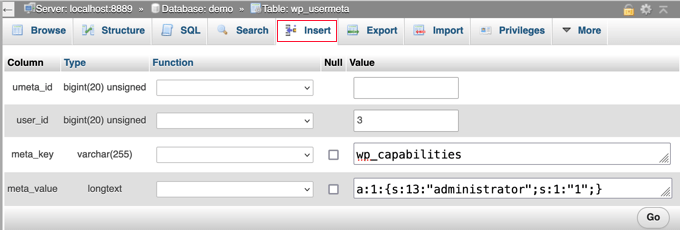
Ensuite, en défilant vers le bas, vous devriez trouver des champs pour une deuxième ligne. Vous devez ajouter les informations suivantes :
unmeta_id: laissez ce champ vide (il sera généré automatiquement)user_id: l’ID de l’utilisateur que vous avez utilisé dans les étapes précédentesmeta_key: vous devez saisirwp_user_levelvaleur_méta: 10

Lorsque vous avez saisi/saisie les informations dans les champs, vous devez cliquer sur le bouton « Go ». Félicitations, vous avez créé un nouvel identifiant d’administrateur !
Vous devriez maintenant pouvoir vous connecter à la zone d’administration de WordPress en utilisant le nom d’utilisateur et le mot de passe que vous avez spécifiés pour cet utilisateur.
Dès que vous vous connectez, vous devez naviguer vers Utilisateurs » Tous les utilisateurs, puis cliquer sur l’identifiant que vous venez de créer.
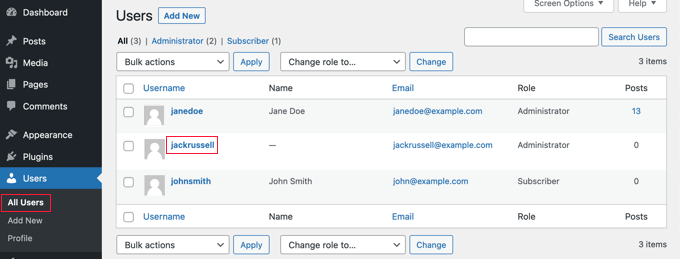
Maintenant, sans rien modifier, défilez jusqu’au bas de la page et cliquez sur le bouton « Enregistrer ».
Cela permettra à WordPress de nettoyer l’utilisateur que vous venez de créer et d’ajouter quelques informations supplémentaires qui sont nécessaires.
Ajout d’un utilisateur/utilisatrices dans la base de données de WordPress à l’aide d’une requête SQL
Si vous êtes développeur/développeuse, vous pouvez accélérer le processus en utilisant du code.
Il suffit d’Avancer cette requête SQL dans votre base de données :
INSERT INTO `databasename`.`wp_users` (`ID`, `user_login`, `user_pass`, `user_nicename`, `user_email`, `user_url`, `user_registered`, `user_activation_key`, `user_status`, `display_name`) VALUES ('3', 'demo', MD5('demo'), 'Your Name', 'test@example.com', 'http://www.example.com/', '2022-09-01 00:00:00', '', '0', 'Your Name');
INSERT INTO `databasename`.`wp_usermeta` (`umeta_id`, `user_id`, `meta_key`, `meta_value`) VALUES (NULL, '3', 'wp_capabilities', 'a:1:{s:13:"administrator";s:1:"1";}');
INSERT INTO `databasename`.`wp_usermeta` (`umeta_id`, `user_id`, `meta_key`, `meta_value`) VALUES (NULL, '3', 'wp_user_level', '10');
Confirmez les modifications apportées à ‘databasename’ pour qu’il corresponde à la base de données avec laquelle vous travaillez.
N’oubliez pas non plus de modifier les autres valeurs pour qu’elles correspondent à celles que vous souhaitez pour le nouvel utilisateur, comme nous l’avons expliqué dans la première méthode.
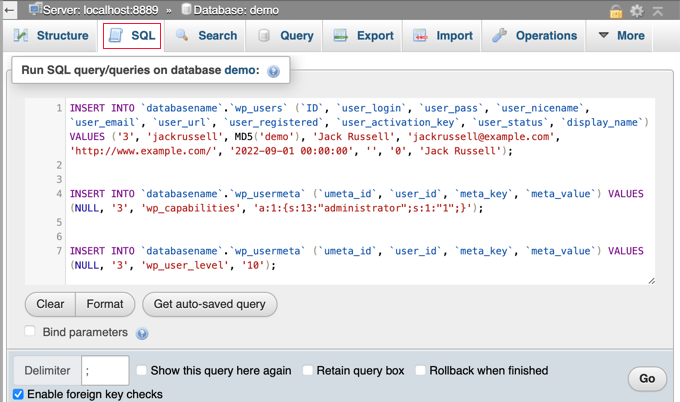
Guides d’experts sur ce qu’il faut faire lorsqu’on est bloqué dans l’administration de WordPress
Maintenant que vous savez comment ajouter un utilisateur administrateur via MySQL, vous pouvez consulter quelques articles sur la façon de corriger votre site lorsque vous êtes bloqué hors de la zone d’administration de WordPress.
- Que faire lorsque vous êtes bloqué hors de l’administration de WordPress (wp-admin)
- Comment utiliser le mode de récupération de WordPress
- Comment réinitialiser un mot de passe WordPress à partir de phpMyAdmin
- Comment débloquer la limitation des tentatives de connexion dans WordPress
- Comment désactiver toutes les extensions lorsqu’on ne peut pas accéder à WP-Admin ?
- Comment corriger l’écran blanc de WordPress (étape par étape)
- Comment corriger l’erreur critique dans WordPress (étape par étape)
- Comment corriger le problème d’actualisation et de redirection de la page de connexion de WordPress ?
- Comment Corrigé l’erreur d’établissement d’une connexion à la base de données dans WordPress
- Comment corriger facilement l’erreur « This Site Can’t Be Reached » (Ce site n’est pas accessible) sur WordPress
Nous espérons que ce tutoriel vous a aidé à apprendre comment ajouter un utilisateur/utilisatrice admin à la base de données WordPress via MySQL. Vous pouvez également consulter notre guide ultime sur la sécurité de WordPress ou notre liste d’erreurs courantes sur WordPress et comment les corriger.
Si vous avez aimé cet article, veuillez alors vous abonner à notre chaîne YouTube pour obtenir des tutoriels vidéo sur WordPress. Vous pouvez également nous trouver sur Twitter et Facebook.





Syed Balkhi says
Hey WPBeginner readers,
Did you know you can win exciting prizes by commenting on WPBeginner?
Every month, our top blog commenters will win HUGE rewards, including premium WordPress plugin licenses and cash prizes.
You can get more details about the contest from here.
Start sharing your thoughts below to stand a chance to win!
Kris says
I wanted to delete all spam emails registered in my site. I went to myPhpAdmin and deleted all including mine (without knowing). I searched the web ’til I landed at this page.
Good Job! It worked!
Donato says
Not sure where I went wrong but I get this when trying to login: You do not have sufficient permissions to access this page.
redhad says
Hello Donato,
Change the « wp_ » prefix of « wp_capabilities » and « wp_user_level » to whatever prefix you have set. Example, if you changed your wordpress prefix as « mysite_ » then the insert command should be:
INSERT INTO `databasename`.`mysite_usermeta` (`umeta_id`, `user_id`, `meta_key`, `meta_value`) VALUES (NULL, ‘4’, ‘mysite_capabilities’, ‘a:1:{s:13: »administrator »;s:1: »1″;}’);
INSERT INTO `databasename`.`mysite_usermeta` (`umeta_id`, `user_id`, `meta_key`, `meta_value`) VALUES (NULL, ‘4’, ‘mysite_user_level’, ’10’);
Chetan Dhiman says
Thanks a lot! It helped me a lot !!!
nishad says
Really great help, I solved my admin access error. Thanks.
Rupert says
Great post – quick not – wp_capabilities and wp_user_level need to match the prefix in the DB…
Lou Storiale says
Thank you for this… very easy to follow! I never would have intuitively thought I would have to add two record in the same table. Thank you again.
WordPress add admin record… I never thought I would have gotten this done in 5 minutes.
Allison Wong says
Thank you! I love when things work! I went through the instructions as stated above and everything worked out. Just a tip – if you changed the prefix of your database tables from wp_ to something else, make sure to replace it in the code above.
Houston says
Thanks, Dasha! You’re a life saver! Was stumped until I saw I needed to also change the DB prefix for ‘wp_capabilities’ and ‘wp_user_level’!
Casey Friday says
This has helped me multiple times, when other developers send me sites to work on without making me an admin account. Thanks!
Ruben says
Hi, thanks for the clear tips. It nearly worked – but had to change a:1:{s:13:”administrator”;s:1:”1″;} with a:1:{s:13: »administrator »;s:1: »1″;} – looks the same, just replace all the quotes (which are curly quotes) with normal quotes. Or don’t be lazy andwrite it instead of cut and paste. Otherwise the new user I created didn’t have admin access. Phew that was difficult,
Reena says
omg.. what a life saver. Just a tip you need to update the wp_capabilities meta_key value to ‘a:1:{s:13: »administrator »;b:1;}’. And for some reason it still didn’t allow me to login. So then I just typed in the new username I created and clicked on forgot password. WP sent me a password reset link and all was well.
captain says
how can i add multiple images into wp_usermeta.
Jamie says
I was able to gain access with the original process but now my dashboard is blank. Any ideas on what I need to do? thanks
Nathan Swartz says
As of today you also have to add another entry (and probably not the wp_user_level, not sure about that though), wp_capabilities with a value of a:1:{s:13: »administrator »;b:1;}
Erik says
You’ve got a small bug. you’ll need to update the wp_capabilities meta_key value to ‘a:1:{s:13: »administrator »;b:1;}’ for this to work correctly, otherwise great article
Gabriel Luethje says
Yep, I got locked out until I figured this one out.
Daniel Duckworth says
Thanks Erik!
mitzi says
Thank you! To both the original author and you for the fix. Saving my bacon right now…
Keenan Flogerzi says
Agreed.
Might be a good idea to post those types of things using code formatting, instead of just regular text.
Dasha says
Thank you for the tutorial – very useful. However, it would be handy if there was a note that ‘wp_capabilities’ and ‘wp_user_level’ use default database prefix, i.e. ‘wp_’. If a site uses a custom DB prefix that it should be used in those strings instead.
Houston says
Thanks, Dasha! You saved me!
Juan says
After finding your sollution i tweaked it a bit you can actually do everything in 2 queries without having to remember the id you create.
Both queries have to be executed in the same action (so the same SQL input box).
INSERT INTO `wp_users` (`ID`, `user_login`, `user_pass`, `user_nicename`, `user_email`, `user_url`, `user_registered`, `user_activation_key`, `user_status`, `display_name`)
VALUES
(NULL , ‘username’, MD5(‘password’), ‘User Name’, ’email@domain.ext’, », NOW(), », ‘0’, ‘User Name’);
INSERT INTO `wp_usermeta` (`umeta_id`, `user_id`, `meta_key`, `meta_value`)
VALUES
(NULL, LAST_INSERT_ID(), ‘wp_capabilities’, ‘a:1:{s:13: »administrator »;s:1: »1″;}’),
(NULL, LAST_INSERT_ID(), ‘wp_user_level’, ’10’);
Sara says
This worked perfectly! Thanks Juan!
codeshark says
This works perfectly and is so much easier than inserting everything manually. Juan, thank you and well done sir.
Jim says
I followed the instructions but keep getting an « invalid username » error when trying to login.
I’ve created 3 different users but still continue getting this error.
AndreaCavallieri says
I have the same problem. How can we solve?
Clare says
So glad I found this. Worked like a dream once I got the correct brackets and the right code for the version of WP that was installed
ReeZh says
It works! running this tuts saving my time. Thanks a lot Mr. Syed.
aleo monts says
GREAT Thanks!
elad says
thanks mate, worked like a charm.
Robin Jennings says
Worked a treat. Nice and simple tutorial- much appreciated.
XYZ says
Thank you very much…it worked.
Abdul Aziz says
not working , i don’t no what mistake i have made…
it’s showing this error
« » » You do not have sufficient permissions to access this page. « »
Steve Della-Valentina says
It seems like the latest version of WordPress has tweaked their meta keys and values to:
dqf_capabilities -> a:1:{s:13: »administrator »;b:1;}
dqf_user_level -> 10
I saw the insufficient permissions prompt before noticing this, then changing the keys and values fixed it!
Alvise says
Hi tried but I always get the same warning : You don’t have permissions……
What can I do??
Thanks!
Andy says
it’s the quotes. Curly quotes are not the same in your DB. Paste that line into your DB, then delete the quotes you pasted in and type new ones.
mbd says
this is solution.. thanks
Ginette says
Was ok one day and then the next – lost my admin access. Thanks for this – saved me a heap of frustration. Plus I’ve learnt some sql to boot!
Cheers!
Joe Hana says
Thanks for this post. Just helped me to save some time. Works great.
Raspal says
Hello,
I had a blog hosted at web host A and moved to another webhost recently. I don’t have the account with web host A any longer but have the full backup of the WP blog on my computer. I restored the backup to this new webhost B and the database as well. The blog is accessible fine. But I’m not able to login to wp-admin using any of the three admin user logins I have in the database. I checked the database from phymyadmin and all the three users are there fine.
I also tried to change passwords of these users. I get the link to change the password, but when I try to login to wp-admin using the new password, even then I get the same WP login screen without any error shown.
I also tried the method you gave above, to create a new user. I did as per all the steps and also tried what the commenters have suggested, but still I’m not able to login.
I tried deleting all the tables for this blog and then again imported the database. Doing this and trying to logging in just gives a message that the database needs to be updated before I can login. So, clicking the yes, I again get the login screen and the above process repeats – getting the same WP login screen with no error.
Note that I’m using the WP Better Security plugin and even tried deleting the plugin using FTP, but the same thing, still.
Can you tell me what can be done in this situation and where am I going wrong? Please help.
Thank you.
Kind Regards,
Raspal
WPBeginner Support says
Please check your wp-config.php file make sure that it has your new database name, username, and host information. Delete .htaccess file from the root of your site. Rename plugins directory in your /wp-content/ folder. This will deactivate all your plugins. Lastly, in phpmyadmin go to wp_options table and look for homeurl and siteurl options make sure they are pointing to your domain name. Report back if none of these steps resolve your issue.
Administrateur
Raspal says
Thanks for the help. I re-checked everything you mentioned above and all those things were perfect. After 2 days of fiddling, it striked me that I hadn’t tried clearing Chrome’s cache and cookies, silly me! This simple thing solved the problems which wasted my two days’ time. Sorry to have wasted your and others’ time too who read this.
Anyway, everyone make sure to clear your cookies and cache every few days, Cookies and cache are responsible for really wierd problems. I don’t know about others but I like to keep my cookies for ages because they contain passwords to many (not-so-important but regular) sites I visit. And I take it for granted that cookies aren’t the culprit. Turned out to be wrong! Now, I have sent myself a reminder which tells me to clear the cookies and cache from all my browsers.
Thanks again for the help. At least the options you mentioned, I will surely remember if something like this happens again. And I also learnt how to use phpmyadmin to create and even edit WP users. And in the process, I saw a table called lockdowns. This is created by WP Better Security plugin and I now know that I can clear this table or change the values if I am locked out of the login screen for bad logins. Thanks Syed and editorial staff!
And in the process, I saw a table called lockdowns. This is created by WP Better Security plugin and I now know that I can clear this table or change the values if I am locked out of the login screen for bad logins. Thanks Syed and editorial staff!
Kind Regards,
Raspal
Colin Steinmann says
There is a very slight (but critical) typo in your tutorial:
a:1:{s:13:”administrator”;s:1:”1″;} <—-this is not correct by a single character
a:1:{s:13:"administrator";s:1:"1";} <—-this is correct, the final ″ should be a "
The two characters look almost exactly the same, but they are slightly different.
Julio says
This was very helpful. I was getting a « not enough access » error. After this tweak, we’re all set.
Alex says
Thank you very much! That was the solution to make this tutorial work nice!!!
Tiago says
Nice, it works!
Just chanced the a:1:{s:13:”administrator”;b:1;} for the equivalent already listed in wp-capabilities and worked fine to me.
Lane says
I’ve followed all these steps, but it doesn’t appear my new user I created has been given admin role. When I log in to WordPress with the username and password I just created all I am able to see is the « Profiles » tab of the dashboard. Obviously I am missing a step along the way, but I have created two new users following this and it’s happened both time. Does anyone know what I may be doing wrong?
Haseeb Ahmad Ayazi says
Can I use this Same Procedure for Multisite…????
Haseeb Ahmad Ayazi says
Didn »t work… I am unable to login in my multisite network. Please Help me
Hope Corizzo says
Wow. Many thanks! php always freaks me out, and I was able to follow this very well. I appreciate it.
Editorial Staff says
Glad it worked out
Administrateur
alan says
This don’t work tried loads of times and still cannot log in.
(unmeta_id – leave this blank (it will be auto-generated)
user_id – this will be the id of the user you created in the previous step. Remember we picked 4.
meta_key – this should be wp_capabilities
meta_value – insert this: a:1:{s:13:”administrator”;s:1:”1″;}
Insert another row with the following information:
unmeta_id – leave this blank (it will be auto-generated)
user_id – this will be the id of the user you created in the previous step. Remember we picked 4.
meta_key – this should be wp_user_level
meta_value – 10 )
this part is where i think i am going wrong , i can see user created but it does not log in
Kristian Lander says
a useful guide, to an issue i found of a hacker who deleted the admin alos. however upon inserting a new admin. i get the error message of INSERT command denied to user « database name » @hosting for table « wp_users »
any ideas?
Anthony says
Thanks, this works a treat. I just copied your SQL and ping! I used MySQL Bench not phpmyadmin.
Oscar Rottink says
Maybe a weird question, but I followed the steps and can’t login. Also watched for the brackets etc.
So I tried ‘forgot password’ and entered my e-mail which is also in the wp_users table. But it says no user is registered with that e-mail.
Anyone a clue what I missed?
Oscar Rottink says
OMG sorry. My fault. I didn’t changed the base URL in the database so my local copy (and login) were pointing at the original site. Feeling stupid.
Adam says
If you copied the code a:1:{s:13: »administrator »;b:1;} from this blog, it is possible that you got curly quotes instead of regular quotes, which will not work.
Gleb says
Man, thanks! Easiest things get easily forgotten You saved me digging through the database for answers..
You saved me digging through the database for answers..
Jasper Frumau says
Thanks for that tip. Now it does work fine and dandy.
Albert A. Ninyeh says
There was a problem with the wp_capabilities valve you gave and the problem was with the quotes. the correct one is: wp_capabilities should be a:1:{s:13: »administrator »;s:1: »1″;}
Anyone who wants to solve this problem should copy it exactly as it appears.
George says
I by accident logged in before adding the « usermeta » info. It of course read « You do not have sufficient permissions to access this page. » Even after I added the usermeta info I get the same thing.
Any thoughts on this?
Editorial Staff says
Check to see if the prefix is the same as your main database prefix. We are assuming that the user is using the default wp_ prefix. If your database prefix is something else, then it wouldn’t work.
Administrateur
Nat says
I’ve tried everything and I still keep getting « You do not have sufficient permissions to access this page. » Any ideas on why this might be happening? Thanks.
David Abramson says
I was getting the same error message and I think the problem comes from the check box in the second row that says « ignore ». It was checked by default for me and I got it to work once I unchecked that box.
JasonC says
Thank you so much this finally allowed me to get into my site. I tried every possible option to reset the admin password but nothing would work. I created the new account and logged in as administrator and was then able to export my work. Thanks again!
Vic Dinovici says
Hi, great article, thanks! Have a different issue though, my entire wp_users table got deleted and I don’t know how to create a wp_users table using phpMyAdmin. Can anyone help? Thanks!
Editorial Staff says
Did you try repairing your database using the WordPress repair tool? Maybe that adds it back. Otherwise, you are better off reinstalling WordPress. For future, keep good backups.
Administrateur
Vic Dinovici says
using the repairing DB WordPress tool won’t create the wp_users table. What I did is deleting the unused tables from the old one, lowering it’s size and uploading it again. It worked. Thanks.
sibz says
After attempting to log in it sais..
You do not have sufficient permissions to access this page
why did this happen?
Thanks
Editorial Staff says
This happens if your user permissions level aren’t correct. Can you make sure that the permission level is the same as the other admin user in your phpMyAdmin
Administrateur
Sibz says
I have applied same user level as 10.
But still does not work
Can my developer have any access to my
Cpanel if she doesnt have my ftp or cpanel
Log in details?
I see in phpmyadmin she is listed as admin.
Its all so confusing especially when im new to all
Of this!
Chris Cox says
Guide is out of date. The correct string for wp_capabilities is now:
a:1:{s:13: »administrator »;s:1: »1″;}
Editorial Staff says
Updated the guide.
Aman Yadav says
Thanks it worked perfectly for me
John says
Thank you. You just saved my arse!!
nimbleswitch says
I echo Ravi’s suggestion to copy the meta value from another admin. In my case « wp_capabilities » was actually databaseName-« _capabilities » and my admin level looked like this: a:2:{s:13: »administrator »;s:1: »1″;s:17: »gform_full_access »;s:1: »1″;}
Thanks for the great article. Saved my day.
Iryna says
Copying of the wp_capabiblities-value from another admin helped me to. In my case the value was a:1:{s:13: »administrator »;s:1: »1″;}. Until this change I had recieved: “You do not have sufficient permissions to access this page.”
ravidreams says
Thanks for the useful article.
a:1:{s:13:”administrator”;b:1;} didn’t work for me. I had to copy the meta value from another admin user and then it worked.
michoscopic says
For those who encounter « You do not have sufficient permissions to access this page. », replace « wp_capabilities » with your full wordpress table name, e.g. if your usermeta tables are called wp_yourtableusermeta (as opposed to wp_usermeta in this tutorial), then you need to use wp_yourtablecapabilities instead. Same goes for wp_user_level, change it to wp_yourtableuser_level. Hope this helps.
MohitBumb says
You do not have sufficient permissions to access this page.
mr.minhkhang says
In my opinion tampering with MySQL should not be on wp’beginner’, messing around with the database is simply not a beginner thing.
I don’t know when this was posted, but the time when WordPress used MD5 has long gone. This article should be updated to use wp_hash_password instead.
Tiago says
One day you need to begin to mess around with not so beginner things.. lols
annedreshfield says
Hi guys, Anne here, community manager intern at Livefyre. Welcome! Just wanted to drop in and say that everyone here loves this blog; it’s full to the brim with fantastic information. Can’t wait to read more!
blainesch says
I was pretty sure the password was md5 but also using a salt stored in the config file it creates.
Kosta Welissariou says
Hi,
I hope to get some help here. My blog was hacked with some base64 stuff. I can solve 99% of all the problems but I have 2 Admins in my wp Backend that need to be removed from mysql table before I can take other actions
Sorry, no clue how to track the adin in the table and remove them
WP latest
Access to the mysql database
tks
Kosta
Editorial Staff says
Look in the wp_users table. Delete the users that you don’t want.
Administrateur
phil says
If it was salted, just follow the steps, add a real email and have it send you a password reset. Boom. hope that helped.
hope that helped.